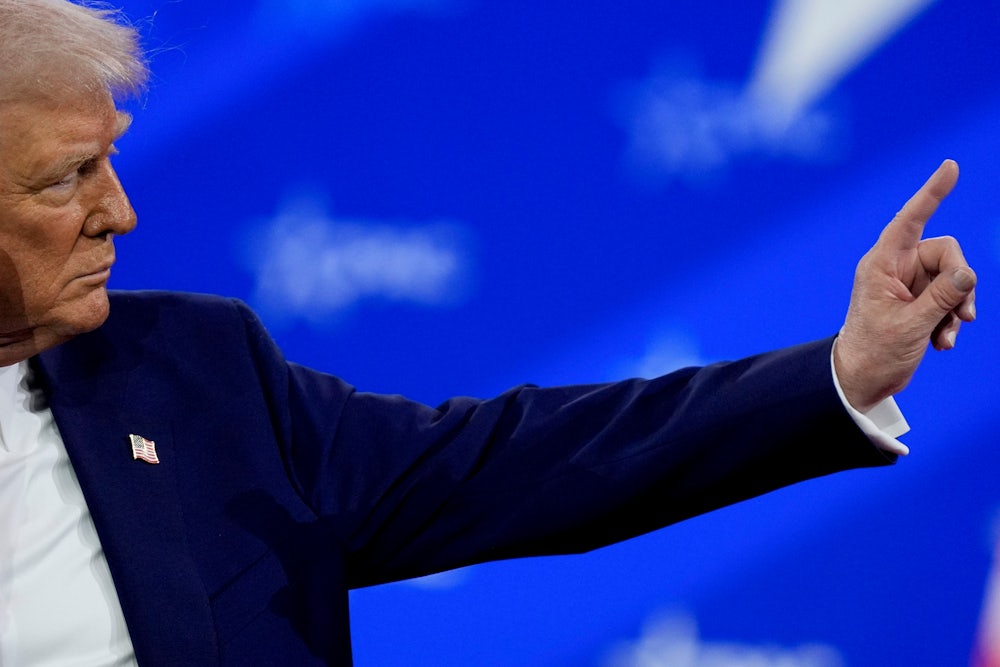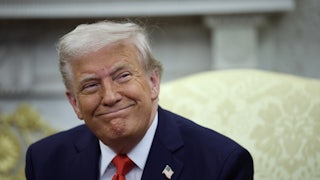After its initial blitzkrieg of executive orders, the Trump administration has increasingly found itself stuck in the soft mud of judicial scrutiny. Whether the president and his allies will decide to openly defy these constraints is an open question.
Earlier this month, for example, Judge Amir Ali ordered the U.S. Agency for International Development, also known as USAID, to unfreeze its funds for aid groups while litigation continued. Multiple aid groups told the court that no such actions have been taken. The State Department, which has taken control of the formerly independent agency, later said that all grants had been frozen department-wide as part of a temporary review by Secretary of State Marco Rubio.
Ali nonetheless reiterated his order last week for USAID to unfreeze the money, despite the government’s efforts to the contrary. “The Court was not inviting Defendants to continue the suspension while they reviewed contracts and legal authorities to come up with a new, post-hoc rationalization for the en masse suspension,” he wrote. “To the extent Defendants have continued the blanket suspension, they are ordered to immediately cease it.”
Judge John McConnell also received intense pushback in recent weeks after he ruled that the Trump administration was defying his temporary order to release federal funds blocked by the White House’s Office of Management and Budget in January. Vice President JD Vance claimed on Twitter that “judges aren’t allowed to control the executive’s legitimate power,” while a White House spokesperson said that any legal challenge to Trump’s executive orders was “nothing more than an attempt to undermine the will of the American people.”
No federal judge has held the Trump administration in contempt of court for its defiance so far, though the possibility remains. It is also possible, of course, that the White House will ultimately bend to adverse judicial rulings against its top policy priorities. If it doesn’t, however, the courts will find it extraordinarily difficult to enforce their own rulings against the administration—or any of the White House’s allies, for that matter.
In normal circumstances, courts would have multiple tools to enforce compliance from defiant litigants. Judges can find people in contempt of court for disobeying their orders or interfering with their proceedings, which can result in fines or imprisonment. They can instruct the U.S. Marshals Service to bring in fugitives, to carry out warrants, and to ensure that the federal judiciary’s orders are generally complied with.
Perhaps the most extraordinary example of this power came in 1906. The Supreme Court agreed to review the case of Ed Johnson, a Black man who had been convicted of rape in Chattanooga, Tennessee, under highly dubious circumstances. After learning of the high court’s intervention, Sheriff Joseph Shipp allowed a lynch mob to enter the jail and hang Johnson from a local bridge.
The justices, outraged by the sheriff’s defiance and backed by President Theodore Roosevelt, brought Shipp and his associates to Washington, D.C., and tried them for contempt of court. He and a handful of others were sentenced to between two and three months in prison in 1909. To this day, United States v. Shipp remains the only criminal trial ever conducted by the Supreme Court. The justices theoretically retain the power to conduct similar trials in the future.
But do not expect to see Chief Justice John Roberts presiding over a criminal trial of Trump anytime soon. Constraining the executive branch is a different beast. Constitutionally speaking, finding the White House in contempt of court is like describing a new color. The primary function of the presidency is to enforce federal law, whether it be the acts of Congress or the rulings of the federal courts. Even then, there are degrees of injury. A president can defy Congress without causing irreparable damage because some friction between the elected branches is built into the constitutional system.
If the president defies the courts and Congress does not impeach him for it, the Constitution simply ceases to exist. There is no backup president whom a judge could call to enforce subpoenas or warrants if the regular one won’t do it. While the U.S. Marshals Service is best known for carrying out the judiciary’s will, it functionally exists as an agency of the Justice Department, and its Senate-confirmed officials can ultimately be fired by Trump himself. There is no reason to believe it would be immune to his will. Last month, the acting marshal for D.C. reportedly visited multiple judges’ chambers to directly pressure them to speed up the releases of prisoners who were pardoned for January 6-related offenses.
Pardons can also be used to nullify the judiciary’s orders. Federal judges have the inherent power to hold defiant litigants and witnesses in criminal contempt of court. (There is also civil contempt of court, but we’ll come back to that later.) Trump has already shown a willingness to pardon people for that offense. The first pardon that he issued during his first term went to former Maricopa County Sheriff Joe Arpaio, who became a national figure for his anti-immigrant politics in the 2010s. A federal court convicted the Arizona sheriff of criminal contempt in July 2017 for defying a federal court order to stop racially profiling Hispanic drivers.
Before Arpaio could be sentenced to up to six months in jail, Trump issued a full pardon to him, citing his history of serving his country. He even previewed the move at a rally where he asked his supporters about the possibility. “So was Sheriff Joe convicted for doing his job?” the president reportedly said. “I’ll make a prediction: I think he’s going to be just fine, OK?” It is not hard to imagine Trump’s “doing his job” logic being applied to his appointees carrying out his orders.
The president’s ability to issue pardons and commutations is arguably his least constrained constitutional power. Acts of executive clemency cannot be overturned by the courts or by Congress. The only explicit constraints in the Constitution are that pardons can only be issued for “offenses against the United States,” meaning they only apply to federal crimes and not state ones and that they do not apply in “cases of impeachment.”
Even so, issuing pardons for contempt of court might seem like an implicit violation of the separation of powers. Unfortunately, the Supreme Court has disagreed. In the 1925 case Ex Parte Grossman, the justices reviewed a pardon issued by President Calvin Coolidge for Chicago saloon owner Phillip Grossman, who had ignored a federal court order to stop selling alcohol during Prohibition.
Newspaper accounts at the time suggested that the pardon came after a friendly senator urged Coolidge to intervene. Judge Kenesaw Mountain Landis, who would become more famous as the first commissioner of baseball, ruled that the pardon was unconstitutional and ordered Grossman to be imprisoned. A group of federal district court judges later upheld that decision, castigating the executive branch for its infringement upon the judiciary’s prerogatives.
“To allow such power in the executive is to strike a death blow at the independence of the judiciary,” Judge George Carpenter wrote for the lower court. “The power to punish for contempt is inherent in, and essential to, the very existence of the judiciary. If the President is allowed to substitute his discretion for that of the courts in this vital matter, then truly the President becomes the ultimate source of judicial authority.”
Judge James Wilkinson, who wrote a concurring opinion, said that he agreed with every word that Carpenter had written. He wrote separately to explain further how the dispute touched upon elemental questions about the basic nature of constitutional government and the rule of law.
If the President has the power to grant the pardon in this case, what becomes of the sanctity of decrees against confiscatory acts of the agents of government, state and national? What becomes of injunctive orders under the interstate commerce, antitrust and kindred statutes? What becomes of the authority of the courts to protect the citizen in the exercise of the rights guaranteed to him by the Constitution, against irreparable injury to life and property? It was well said that the power to tax is the power to destroy; it is just as true that the power to pardon for contempt is the power to destroy judicial authority.
Grossman and the Justice Department then asked the Supreme Court to intervene. Chief Justice William Howard Taft, writing for the court, rejected the lower court’s ruling altogether and ordered Grossman’s release. He concluded that the Constitution’s description of “crimes against the United States” should be read as broadly as possible and not limited merely to the offenses defined by Congress in federal law, such as contempt of court.
Taft’s ruling was highly deferential to the executive branch, an approach that is perhaps unsurprising since he had previously led it. He argued against a strict separation of powers, noting that the various branches had tools to check and balance each other and that the pardon power was one of them. Taft also rejected as fanciful the idea that his interpretation could be used maliciously by a future president.
“If it be said that the president, by successive pardons of constantly recurring contempts in particular litigation, might deprive a court of power to enforce its orders in a recalcitrant neighborhood, it is enough to observe that such a course is so improbable as to furnish but little basis for argument,” he wrote. Even in the unlikely event that a president actively sought to thwart judicial rulings, the chief justice explained, the other branches could still check him.
“Exceptional cases like this, if to be imagined at all, would suggest a resort to impeachment rather than to a narrow and strained construction of the general powers of the President,” Taft continued. In other words, even more unimaginable to him than a rogue, lawless president was a Congress that would do nothing to constrain him.
At the same time, Taft noted that the pardon power could not be used to completely evade a court’s sanctions. “For criminal contempts, the sentence is punitive in the public interest to vindicate the authority of the court and to deter other like derelictions,” he explained. “For civil contempts, the punishment is remedial and for the benefit of the complainant, and a pardon cannot stop it.”
Civil contempt differs from criminal contempt in a few key ways. With civil contempt, a judge can issue a fine for each day that a litigant refuses to comply with a court order, or they could order someone to be held in jail until they agree to cooperate with the court. Since these aren’t punitive, as Taft noted, they can’t be wiped away by a pardon. But their coercive power would be limited when the president is involved, as the courts would still depend on other actors to enforce their will.
Congress, in theory, could supplement the judiciary’s authority in such a showdown with its own. President Richard Nixon complied with the Supreme Court’s order to turn over the White House tapes to a grand jury during the Watergate crisis in part because lawmakers would impeach him if he didn’t. That likely won’t happen this time. Over the last month, Republican members of Congress have introduced articles of impeachment in response to the courts’ orders—but against the judges who issued them, not the president who is defying them.
The Constitution—and the Framers who drafted it—did a decent job at devising a structure for government that would allow the different branches to check one another to preserve liberty. No constitutional text is well written enough to save the rule of law when the American people elect a president who doesn’t believe in the Constitution, especially when he is joined by a Congress that refuses to hold him accountable for violating it.










